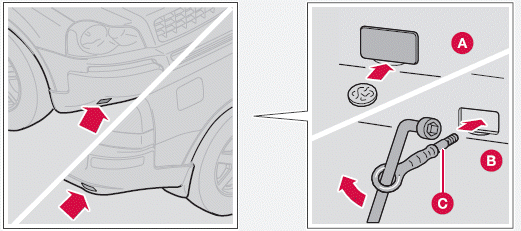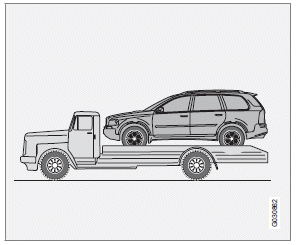Towing


Positions for attaching towing eyelets
Emergency towing
The towing eyelet is located in the tool bag, under the floor of the cargo area. This eyelet must be screwed into the positions provided on the right sides of either the front or rear bumper (see illustrations).
To attach the towing eyelet
1. Use a coin to pry open the lower edge of
the cover (A)
2. Screw the towing eyelet (C) in place (B),
first by hand and then using the tire iron
until it is securely in place.
After the vehicle has been towed, the eyelet should be removed and returned to the tool bag. Press the cover back into position.
WARNING
Do not use the towing eyelets to pull the
vehicle up onto a flat bed tow truck.
Precautions when the vehicle is in tow
Х The steering wheel must be unlocked. Turn
the ignition key to position I or II.
Х The gear selector must be in position N.
Х Maximum speed: 50 mph (80 km/h). Do not
exceed the maximum allowable towing
speed.
Х Maximum distance with front wheels on
ground: 50 miles (80 km).
Х While the vehicle is being towed, try to
keep the tow rope taut at all times.
Х The vehicle should only be towed in the
forward direction.
CAUTION
Vehicles with AWD (All Wheel Drive) with the
front wheels off the ground should not be
towed at speeds above 50 mph (70 km/h) or
for distances longer than 30 miles (50 km).
CAUTION
Х Please check with state and local
authorities before attempting this type
of towing, as vehicles being towed are
subject to regulations regarding maximum
towing speed, length and type of
towing device, lighting, etc.
Х If the vehicle's battery is dead, do not
attempt to start the vehicle by pushing
or pulling it as this will damage the
three-way catalytic converter(s). The
engine must be jump started using an
auxiliary battery.
Х If the vehicle is being towed on a flat bed
truck, the towing eyelets must not be
used to pull the vehicle up onto the flat
bed or to secure the vehicle on the flat
bed. Consult the tow truck operator.
WARNING
Х Remember that the power brakes and
power steering will not function when
engine is not running. The braking and
steering systems will function but considerably
higher pressure will be
required on the brake pedal and greater
steering effort must be exerted.
Х The towing eyelets must not be used for
pulling the vehicle out of a ditch or for
any similar purpose involving severe
strain. Do not use the towing eyelets to
pull the vehicle up onto a flat bed tow
truck.

See also:
Opening/closing the fuel cap
Fuel vapor expands in hot weather. Open the filler cap slowly.
After refueling, close the fuel filler cap by turning it clockwise until it clicks
into place.
CAUTION
Do not refuel with the e ...
Child restraint systems
Child restraints
Infant seat
There are three main types of child restraint
systems: infant seats, convertible seats, and
booster cushions. They are classified according
to the child's age an ...
Vanity mirror lighting
Removing the mirror glass
1. Insert a screwdriver underneath the lower
edge, in the center, turn and carefully pry
up the lug on the edge.
2. Carefully detach and lift out the entire mirror
...
